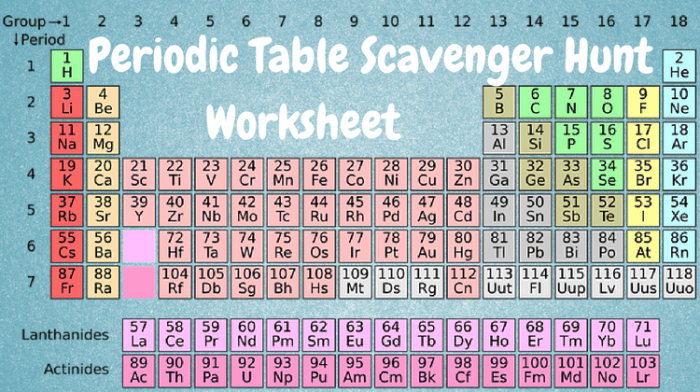The Periodic Table of Elements Scavenger Hunt is an engaging and educational activity that combines the excitement of a scavenger hunt with the learning of chemistry. This hunt challenges participants to explore the periodic table, discover element properties, and apply their knowledge in a fun and interactive way.
Through a series of clues and puzzles, participants navigate the periodic table, uncovering the unique characteristics of each element. This hands-on approach enhances understanding of element trends, applications, and their significance in the world around us.
Scavenger Hunt Overview: Periodic Table Of Elements Scavenger Hunt

A scavenger hunt is a game where participants follow clues to find hidden objects or information. It can be a fun and engaging way to learn about a topic. A scavenger hunt can be tailored to the periodic table of elements by creating clues that relate to the properties and characteristics of the elements.
The objectives of a scavenger hunt are to:
- Provide a fun and engaging way to learn about the periodic table.
- Challenge participants to think critically and creatively.
- Encourage teamwork and collaboration.
Element-Based Clues, Periodic table of elements scavenger hunt
Clues in a periodic table scavenger hunt can be based on any aspect of the elements, such as their atomic number, atomic mass, electron configuration, or chemical properties. For example, a clue could ask participants to find the element with the highest atomic number, or the element that is a noble gas.
When designing clues, it is important to make them challenging but not impossible to solve. Clues should also be informative, so that participants can learn something new about the elements as they play the game.
QR codes or other digital elements can be used to enhance the hunt. For example, a QR code could link to a website with more information about an element, or to a video of an experiment that demonstrates an element’s properties.
Table Organization and Accessibility
The periodic table is organized by atomic number, with the elements arranged in rows (periods) and columns (groups). The table is divided into four blocks: the s-block, the p-block, the d-block, and the f-block.
To make the table accessible for participants with different learning styles, it is helpful to use color-coding, symbols, or other visual cues to highlight different groups of elements. For example, the alkali metals could be highlighted in blue, the halogens in green, and the noble gases in yellow.
Gamification and Scoring
Gamification is the use of game elements in non-game contexts to make activities more engaging and motivating. Gamification can be used in a scavenger hunt to encourage participation and make the learning experience more fun.
There are many different scoring systems that can be used in a scavenger hunt. One common system is to award points for each clue that is solved. Another system is to award points for completing certain tasks, such as finding a specific element or answering a question about an element.
Rewards or incentives can be offered to successful participants. These rewards could include prizes, such as gift cards or books, or recognition, such as a certificate of achievement.
Educational Benefits
A periodic table scavenger hunt can be a valuable educational tool. The hunt can help participants to:
- Learn about the elements and their properties.
- Understand the organization of the periodic table.
- Develop critical thinking and problem-solving skills.
- Work collaboratively with others.
The hunt can also be integrated into a science curriculum. For example, the hunt could be used to review the elements before a test, or to introduce a new topic, such as chemical reactions.
Questions and Answers
What is the purpose of a periodic table scavenger hunt?
A periodic table scavenger hunt aims to enhance understanding of element properties, trends, and applications through an interactive and engaging activity.
How can I make the scavenger hunt accessible for different learning styles?
Use color-coding, symbols, or visual cues to facilitate navigation and provide clues that cater to diverse learning preferences.
What are some examples of clues that could be used in a periodic table scavenger hunt?
Clues can include element symbols, atomic numbers, group or period information, or descriptions of element properties or uses.
